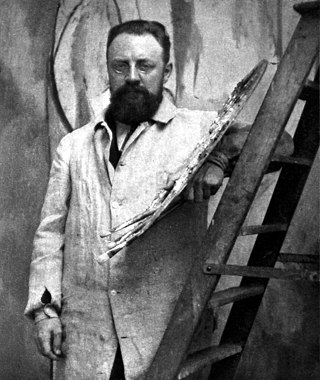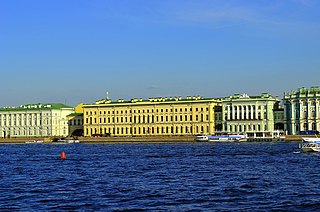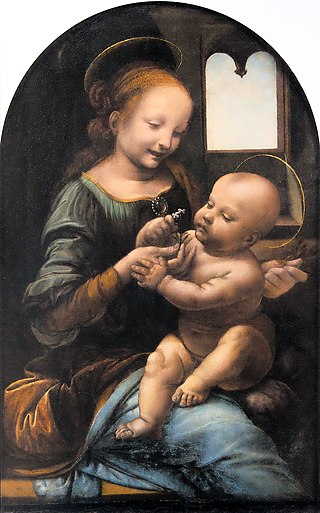
Henri Émile Benoît Matisse was a French visual artist, known for both his use of colour and his fluid and original draughtsmanship. He was a draughtsman, printmaker, and sculptor, but is known primarily as a painter. Matisse is commonly regarded, along with Pablo Picasso, as one of the artists who best helped to define the revolutionary developments in the visual arts throughout the opening decades of the twentieth century, responsible for significant developments in painting and sculpture.

The State Hermitage Museum is a museum of art and culture in Saint Petersburg, Russia. It is the second largest art museum in the world by gallery space. It was founded in 1764 when Empress Catherine the Great acquired an impressive collection of paintings from the Berlin merchant Johann Ernst Gotzkowsky. The museum celebrates the anniversary of its founding each year on 7 December, Saint Catherine's Day. It has been open to the public since 1852. The Art Newspaper ranked the museum 6th in their list of the most visited art museums, with 1,649,443 visitors in 2021.

Bartolomé Esteban Murillo was a Spanish Baroque painter. Although he is best known for his religious works, Murillo also produced a considerable number of paintings of contemporary women and children. These lively realistic portraits of flower girls, street urchins, and beggars constitute an extensive and appealing record of the everyday life of his times. He also painted two self-portraits, one in the Frick Collection portraying him in his 30s, and one in London's National Gallery portraying him about 20 years later. In 2017–18, the two museums held an exhibition of them.

The Benois Madonna, otherwise known as the Madonna and Child with Flowers, is a painting by the Italian Renaissance master Leonardo da Vinci in the Hermitage Museum, Saint Petersburg. One of two Madonnas begun by Leonardo in October 1478, it was completed c. 1478–1480; the other was the Madonna of the Carnation, now in the Alte Pinakothek, Munich.

The Madonna Litta is a late 15th-century painting, traditionally attributed to Leonardo da Vinci, in the Hermitage Museum, Saint Petersburg. It depicts the Virgin Mary breastfeeding the Christ child, a devotional subject known as the Madonna lactans. The figures are set in a dark interior with two arched openings, as in Leonardo's earlier Madonna of the Carnation, and a mountainous landscape in aerial perspective can be seen beyond. In his left hand Christ holds a goldfinch, which is symbolic of his future Passion.

Juan de Pareja was a Spanish painter born in Antequera, near Málaga, Spain. He is known primarily as a member of the household and workshop of painter Diego Velázquez, who enslaved him until 1650. His 1661 work The Calling of Saint Matthew is on display at the Museo del Prado in Madrid, Spain.

Picasso's African Period, which lasted from 1906 to 1909, was the period when Pablo Picasso painted in a style which was strongly influenced by African sculpture, particularly traditional African masks and art of ancient Egypt, in addition to non-African influences including Iberian sculpture, and the art of Paul Cézanne and El Greco. This proto-Cubist period following Picasso's Blue Period and Rose Period has also been called the Negro Period, or Black Period. Picasso collected and drew inspiration from African art during this period, but also for many years after it.

Dance (La Danse) is a painting made by Henri Matisse in 1910, at the request of Russian businessman and art collector Sergei Shchukin, who bequeathed the large decorative panel to the Hermitage Museum in Saint Petersburg, Russia. The composition of dancing figures is commonly recognized as "a key point of (Matisse's) career and in the development of modern painting". A preliminary version of the work, sketched by Matisse in 1909 as a study for the work, resides at MoMA in New York City, where it has been labeled Dance (I).

The Conversation, a painting by Henri Matisse dating from 1908 to 1912, depicts the artist and his wife facing each other before a background of intense blue. It is in the collection of the Hermitage Museum in Saint Petersburg, Russia.

Leandro Bassano, also called Leandro dal Ponte, was an Italian artist from Bassano del Grappa who was awarded a knighthood by the Doge of Venice. He was the younger brother of artist Francesco Bassano the Younger and third son of artist Jacopo Bassano. Their father took his surname from their town of Bassano del Grappa, and trained his sons as painters.

Friar Juan Bautista Maíno, or Mayno was a Spanish Baroque painter.

Lady in Blue is an oil on canvas painting by Paul Cézanne, executed c. 1900, now in the Hermitage Museum in Saint Petersburg, Russia.
Cecilia Paredes is a Peruvian-born multimedia artist residing in Philadelphia. Her primary themes include the power of nature, femininity, and migration, which have been subjects of many of her shows. She frequently utilizes natural elements, often recycled waste materials and primarily organic ones, in her installations. One of her best-known works is "Paisajes" in which she camouflages herself and uses her own figure as a canvas for body painting.

The Virgin Mary as a Child Praying is a 1658–1660 painting by Francisco de Zurbarán, now in the Hermitage Museum in St Petersburg. Its theme is similar to that of his The Young Virgin. The painter completed the work in Madrid a few years before his death.

The Port of Marseille is a 1907 oil on canvas Pointillist painting by Paul Signac, now in the Hermitage Museum, St Petersburg, Russia. The city's ships and port were a favourite subject of the painter, who also produced The Port of Marseille (1884), A View of Marseille (1905) and The Port of Marseille (1931).

Isaac Blessing Jacob is a 1665-1670 oil on canvas painting by Bartolomé Esteban Murillo, forming a pair with Jacob's Dream. Both paintings were acquired via Dominique Vivant Denon in Paris in 1811 for the Hermitage Museum, in Saint Petersburg, where they still hang, along with 26 other works by the artist and his studio.















